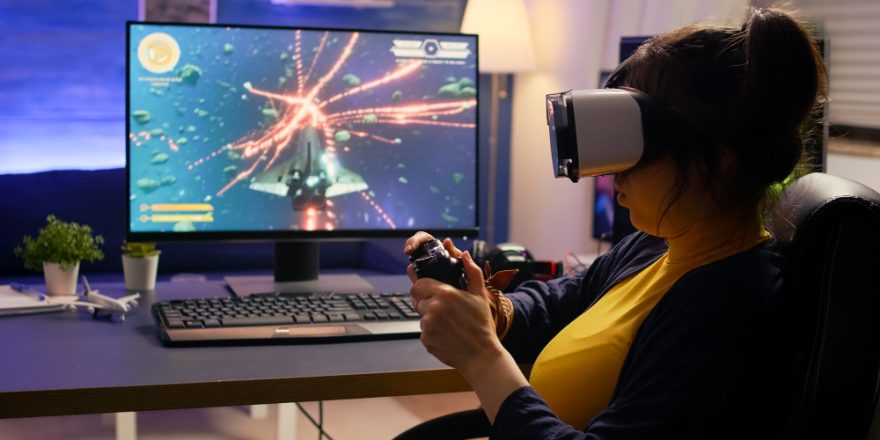Virtual reality (VR) gaming has come a long way since its inception, offering immersive experiences that transport players to fantastical worlds and push the boundaries of interactive entertainment. As technology continues to evolve and VR hardware becomes more accessible, the future of virtual reality gaming is brighter than ever before. In this comprehensive guide, we’ll explore the latest trends, cutting-edge technologies, and thrilling experiences that are shaping the future of VR gaming. From advanced haptic feedback and photorealistic graphics to social VR platforms and location-based experiences, the future of VR gaming promises to revolutionize the way we play, connect, and explore virtual worlds.
The Evolution of Virtual Reality Gaming
What is Virtual Reality Gaming?
Virtual reality gaming is a form of interactive entertainment that uses VR technology to create immersive simulated environments that players can explore and interact with. By wearing a VR headset and using motion controllers or other input devices, players can step into virtual worlds, manipulate objects, and engage in gameplay experiences that feel lifelike and immersive.
The Rise of VR Gaming
Virtual reality gaming has experienced significant growth in recent years, thanks to advancements in VR technology, the proliferation of VR hardware, and the development of compelling VR experiences. With the introduction of consumer-grade VR headsets such as the Oculus Rift, HTC Vive, and PlayStation VR, VR gaming has become more accessible to mainstream audiences, leading to a surge in popularity and demand for VR content.
Trends Shaping the Future of VR Gaming
Advanced Haptic Feedback
One of the most exciting trends in VR gaming is the development of advanced haptic feedback systems that provide more immersive tactile sensations. From haptic gloves and vests to full-body suits, these devices use vibration, pressure, and motion to simulate the sensation of touch, allowing players to feel the impact of virtual objects and interactions in the game world.
Photorealistic Graphics
As VR hardware becomes more powerful and capable, developers are pushing the boundaries of graphical fidelity in VR games, striving to create photorealistic environments and characters that rival the visual quality of real life. With advancements in rendering technology, lighting effects, and texture resolution, VR games are becoming more immersive and visually stunning than ever before, blurring the line between reality and virtuality.
Social VR Platforms
Social VR platforms are emerging as popular destinations for VR gamers to connect, interact, and play together in virtual spaces. From virtual hangouts and multiplayer games to immersive chat rooms and virtual events, social VR platforms offer new opportunities for socialization and collaboration in VR, enabling players to meet new friends, join communities, and share experiences in virtual worlds.
Location-Based VR Experiences
Location-based VR experiences are immersive entertainment attractions that combine VR technology with physical spaces to create unforgettable interactive experiences. From VR arcades and theme park attractions to VR escape rooms and immersive theaters, location-based VR experiences offer unique opportunities for players to explore virtual worlds and embark on thrilling adventures in real-world settings.
Technologies Driving the Future of VR Gaming
Wireless VR
Wireless VR technology allows players to experience VR without being tethered to a PC or console, offering greater freedom of movement and flexibility. With advancements in wireless VR headsets and streaming technology, players can enjoy high-quality VR experiences without the limitations of cables or wires, making VR gaming more accessible and convenient than ever before.
Eye Tracking
Eye tracking technology is revolutionizing VR gaming by enabling more natural and intuitive interactions with virtual environments. By tracking the movement of the player’s eyes, VR headsets can adjust the focus of virtual objects, simulate depth of field effects, and enhance the realism of gaze-based interactions, leading to more immersive and responsive gameplay experiences.
Foveated Rendering
Foveated rendering is a rendering technique that optimizes graphics performance in VR by dynamically adjusting the level of detail based on where the player is looking. By focusing rendering resources on the player’s foveal vision—the central area of highest visual acuity—foveated rendering can significantly improve rendering efficiency and reduce the computational burden of rendering high-resolution VR graphics, leading to smoother frame rates and more realistic visuals.
The Impact of VR Gaming on Health and Well-being
Virtual reality gaming has the potential to impact not only entertainment but also health and well-being. Studies have shown that VR gaming can provide therapeutic benefits, such as reducing stress, anxiety, and depression, and improving cognitive function and motor skills. VR-based interventions have been used to treat a variety of mental health conditions, including phobias, PTSD, and addiction, by providing immersive and interactive experiences that help users confront and overcome their fears and challenges in a safe and controlled environment.
The Future of VR Gaming Accessibility
Accessibility is an important consideration for the future of VR gaming, as developers strive to make VR experiences more inclusive and accessible to players of all abilities. Efforts are underway to develop accessible VR hardware and software solutions, such as adaptive controllers, customizable user interfaces, and assistive technologies, to ensure that everyone can enjoy the benefits of VR gaming regardless of their physical or cognitive limitations. By prioritizing accessibility and inclusivity, the future of VR gaming can become more diverse, equitable, and welcoming for players from all walks of life.
The Ethical and Social Implications of VR Gaming
As VR gaming becomes more prevalent and immersive, it raises important ethical and social questions about the impact of virtual experiences on our perceptions, behaviors, and relationships. Issues such as virtual identity, privacy, consent, and digital addiction have become increasingly relevant in the context of VR gaming, prompting discussions about the ethical guidelines and regulations needed to ensure responsible development and use of VR technology. By addressing these ethical and social implications proactively, the future of VR gaming can foster positive experiences and outcomes for players while minimizing potential risks and harms.
The Role of VR Gaming in Shaping the Metaverse
The concept of the metaverse—a collective virtual shared space that encompasses virtual worlds, augmented reality, and the internet—is gaining traction as VR technology continues to advance. VR gaming is poised to play a central role in shaping the metaverse, providing immersive and interactive experiences that enable users to connect, communicate, and collaborate in virtual environments. From virtual economies and social interactions to virtual events and cultural experiences, VR gaming can help create a vibrant and dynamic metaverse that blurs the boundaries between the physical and digital worlds, offering endless opportunities for exploration, creativity, and expression.
The Future of VR Gaming Content Creation
Content creation is a key driver of innovation and growth in the VR gaming industry, as developers and creators explore new ways to push the boundaries of storytelling, immersion, and interactivity. With the advent of user-generated content platforms, such as VRChat and Rec Room, players have the opportunity to create and share their own VR experiences, from virtual worlds and games to immersive narratives and social experiences. As VR gaming content creation tools become more accessible and user-friendly, the future of VR gaming promises to be driven by the creativity, imagination, and ingenuity of players and creators around the world.
FAQs
Q1: What are some of the challenges facing the future of VR gaming?
- While VR gaming has made significant strides in recent years, there are still challenges to overcome, including the high cost of VR hardware, the need for more compelling VR content, and concerns about motion sickness and VR-induced discomfort. Additionally, achieving widespread adoption of VR gaming will require continued advancements in technology, as well as efforts to address accessibility and affordability barriers.
Q2: How can developers create more immersive VR experiences?
- Developers can create more immersive VR experiences by leveraging advanced technologies such as haptic feedback, photorealistic graphics, and social VR platforms. By focusing on interactive storytelling, realistic physics simulations, and intuitive user interfaces, developers can create VR games that captivate players and transport them to new worlds of imagination and adventure.
Q3: What role will VR play in the future of gaming and entertainment?
- VR is poised to play a significant role in the future of gaming and entertainment, offering immersive and interactive experiences that transcend traditional forms of media. From immersive storytelling and virtual tourism to virtual concerts and live events, VR has the potential to revolutionize how we play, connect, and experience entertainment in the digital age.
Q4: How can VR gaming contribute to education and training?
- VR gaming can be a powerful tool for education and training, allowing students and professionals to engage in realistic simulations, hands-on learning experiences, and interactive training scenarios. From virtual classrooms and medical simulations to corporate training programs and vocational skills training, VR gaming can provide immersive and engaging learning opportunities that enhance retention, comprehension, and skill development.
Q5: What are some emerging trends and technologies to watch out for in the future of VR gaming?
- Some emerging trends and technologies to watch out for in the future of VR gaming include augmented reality (AR) integration, brain-computer interfaces (BCIs), and volumetric capture. These technologies have the potential to further enhance the immersion, interactivity, and realism of VR experiences, opening up new possibilities for creativity, innovation, and exploration in the world of virtual reality.
Conclusion
The future of virtual reality gaming is filled with excitement, innovation, and endless possibilities. From advancements in technology and trends shaping the industry to the impact on health and well-being, accessibility, ethics, and the metaverse, VR gaming is poised to revolutionize how we play, connect, and explore virtual worlds. By embracing the potential of VR technology and addressing the opportunities and challenges ahead, the future of VR gaming can become a transformative force for entertainment, education, and social interaction, unlocking new frontiers of creativity, immersion, and exploration for players and creators alike. So, strap in and get ready for an exhilarating journey into the future of virtual reality gaming—a world where anything is possible, and adventure awaits around every corner.





